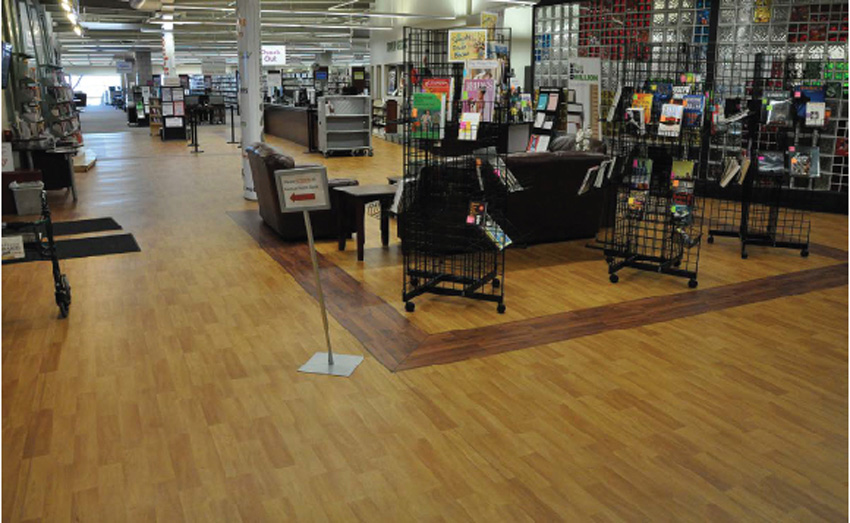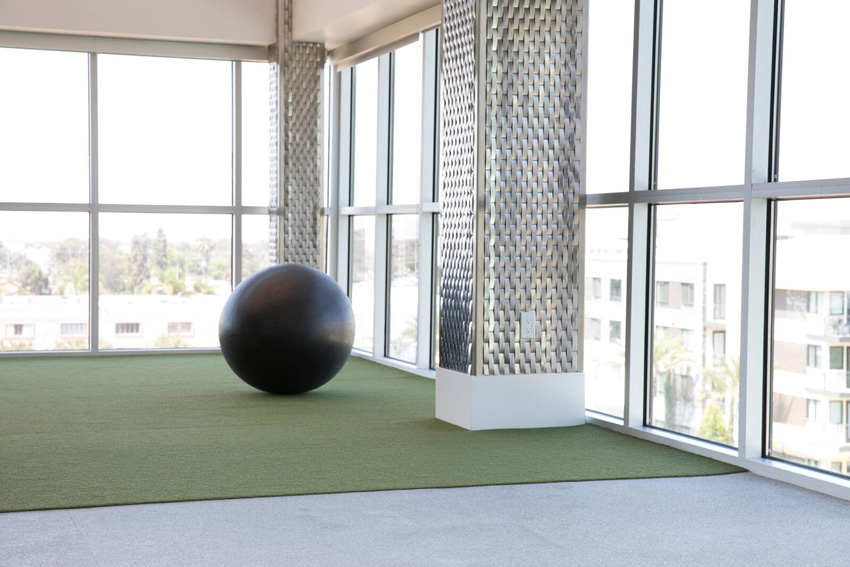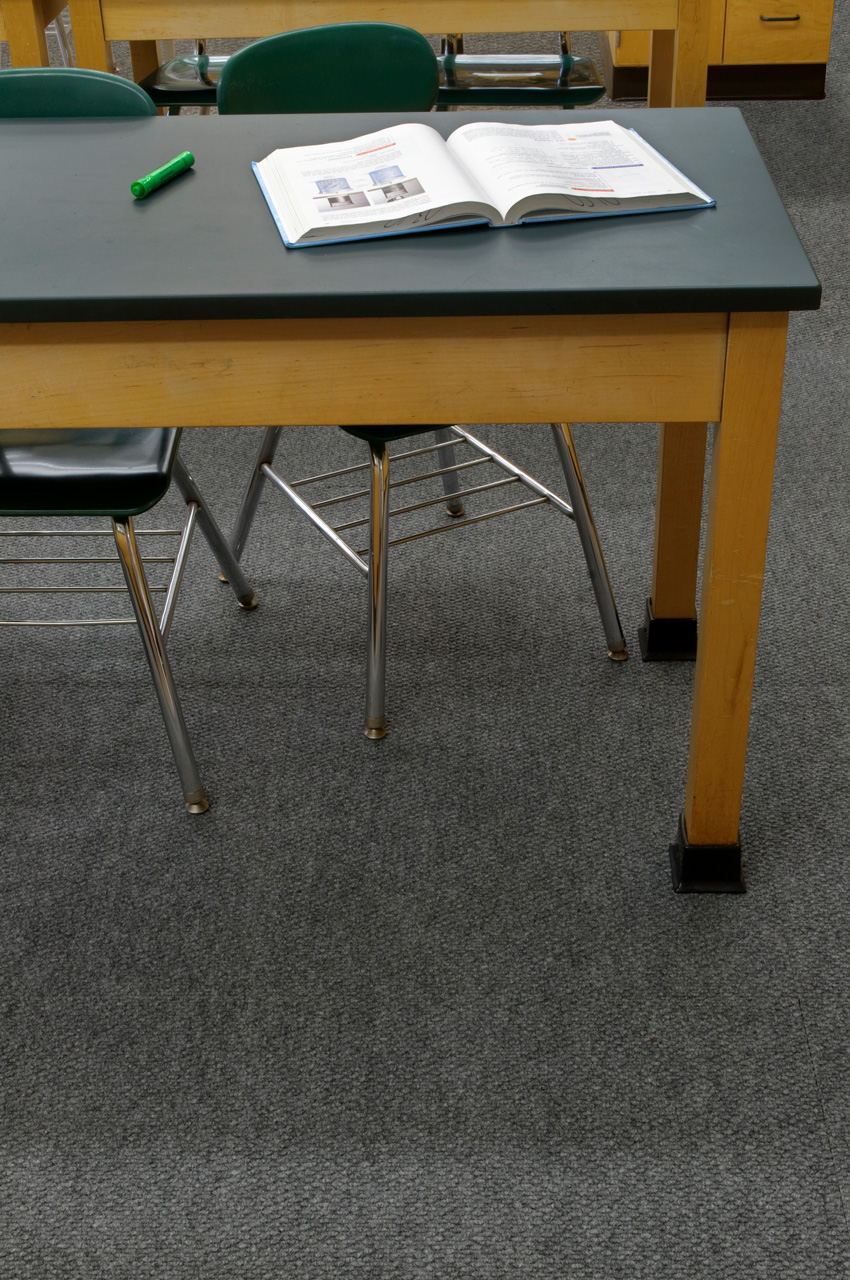Defining Performance in Flooring
Performance Flooring: Acoustics

In the Paseo Verde Library in Las Vegas, an adjacent cafe presented noise and maintenance challenges. An engineered performance surface was selected to replace difficult-to-maintain carpet and ensure that the library remained quiet.
As occupant health and wellness become ever more important aspects of the built environment, ensuring good acoustics should be a fundamental part of the design process. Acoustics can affect a building occupant’s experience in many ways, including stress from noise, sleep disturbance, worker productivity, speech intelligibility, privacy, and patient outcomes in hospitals. The flooring choice is a vital consideration for good acoustics and contributes greatly to the control of impact noise from footsteps, dropped items, dragging chairs, fitness areas, and more.
In the past, carpet was a common flooring choice for apartments, hotels, offices, and schools. The soft nature of carpet greatly reduces impact noise, and its common use meant that impact noise was not a major issue. As designers move more and more to a modern aesthetic that minimizes carpet and instead emphasizes hard floor surfaces, impact noise has become a much more critical consideration. Other flooring materials are needed to supplement the standard hard flooring surfaces and provide the impact insulation once taken for granted with carpet.
For example, acoustics were obviously a prime consideration when new surfacing was selected to replace shredded and discolored 12-year-old carpet in the Paseo Verde Library in Las Vegas. The engineered performance surface selected is “just as quiet as carpet,” says Joan Dalusung, manager of the Paseo Verde Library. “We have been very happily surprised about that. It’s not just people walking across it; we are constantly rolling book carts and small furniture over it, and it has not only held up wonderfully, but the space has remained quiet. It has surpassed our expectations on an acoustic level.”
A growing trend toward more prevalent and expansive fitness facilities means they are now more often located near noise-sensitive spaces, such as hotel rooms, apartments, offices, conference rooms, and classrooms. A traditional stand-alone gym may not produce many acoustical issues, but a large fitness center located above guestrooms in a high-end hotel can present major issues for noise control.
In all these instances, proper flooring selection is a critical part of achieving the project design goals. With regard to acoustics, performance flooring primarily serves to reduce the sound from impacts (footsteps, weight drops, etc.) and other floor interactions (dragging a chair, rolling carts, rolling hospital beds, etc.). Performance flooring does this in two main areas:
- Rooms outside the space where the impacts or floor interactions occur. The most common example is the noise from footsteps in an upper apartment affecting the downstairs neighbor. However, other impacts, such as dropping heavy weights in a gym, can affect spaces below, beside, and above where the impact occurs. Noise from footfalls is commonly addressed using the impact insulation class (IIC) and ΔIIC ratings. IIC is a single-number rating that indicates the amount of impact insulation provided by a floor-ceiling assembly. Delta IIC (written as ∆IIC) is a measure of the improvement from adding flooring and/or underlayment to a bare concrete slab.
- Rooms where the impacts or floor interactions occur. This is a major issue in health-care facilities where noise from footsteps and rolling carts in the hallway can have a major impact on a patient’s ability to relax, sleep, and heal. Other examples are performing-arts venues and churches where carpet has typically been used in the aisles to reduce noise from people’s movement. There is currently no industry standard to measure surface-generated noise, though one is under development by ASTM.
Acoustical underlayments are the most common method of improving the impact noise reduction of a floor. They can be placed directly beneath the finished floor or between the subflooring and a gypsum concrete topping, for instance. As discussed in this course, new engineered surface products include an acoustical underlayment fusion bonded to the underside of the finish flooring. These engineered surfaces can reduce impact noise transmitted to adjacent spaces as well as surface-generated noise within the space where the impact occurs.
Standard acoustical underlayments used to address transmission of impact noise to adjacent spaces are usually less than half an inch thick and measured using the IIC and ΔIIC ratings. These can be very effective for reducing footfall noise, but they are generally insufficient when trying to control noise from heavy-weight impacts in gyms and the like. To effectively reduce impact noise from heavy weights, far more robust flooring solutions are needed. There are rollout flooring products and flooring tiles specifically designed to address heavy-weight impacts. These products are significantly thicker (up to 2.5 inches and more) than standard underlayments and provide substantial deflection to help absorb the energy of the weight impact. Careful use of these products can help address noise complaints when fitness areas are located near noise-sensitive spaces, such as hotel rooms and apartments. The ΔIIC and IIC tests use light weights (0.5 kilogram, or roughly 1 pound), resulting in an inaccurate indication of a floor’s performance under heavy-weight impacts, like those experienced in a gym and other fitness areas. Presently, there is no recognized standard for testing heavy-weight impacts, so designers should gather as much information as possible when comparing weight impact data from different manufacturers.
Although there is currently no standard test for surface-generated noise, in general, softer flooring generates less noise than hard flooring. A good example is the difference between a dog running on carpet and a dog running on hardwood flooring. On a hardwood floor, one can clearly hear the clatter of the dog’s nails hitting the floor, but on carpet, this sound is mostly absent. Some resilient flooring surfaces are engineered for noise control similar to soft surfaces like carpet.

As urban density increases, fitness facilities are frequently located near noise-sensitive spaces, such as hotel rooms, apartments, offices, conference rooms, and classrooms. Pictured here is Vive on the Park, an upscale apartment complex in San Diego featuring a gym over apartments. Several engineered surfaces with composition rubber backing were used in this space, protecting occupants from noise while coordinating with the sleek, contemporary styling of the rest of the building.
Many designers are familiar with the acoustical requirements (STC and IIC 50) incorporated in the building code for multifamily residential buildings: ICC G2 – 2010 Guideline for Acoustics. These requirements are typically included in municipal building codes and are therefore usually a legal requirement for multifamily construction. There are many other acoustical standards for various building types that may be less commonly known, including health care, education, and hospitality. Many hotel chains have their own development standards that include acoustical requirements.
Whatever the project type, it is imperative that designers are aware of any and all acoustical performance standards that apply to the project, and manufacturers should be able to help evaluate flooring products that will contribute to meeting those standards. For example, manufacturers of effective, properly tested flooring products should be able to provide both IIC and ∆IIC numbers, as well as data on alternative assemblies, so designers can make a realistic comparison based on accurate predictions of performance.

In the past, carpet was a common flooring choice to reduce impact noise. This performance floor in the Lancaster Country Day School in Lancaster, Pennsylvania, features a carpet wear layer fusion bonded to a composition rubber backing, improving the acoustic, ergonomic, and safety performance of the flooring.
Key Acoustics Terms and Criteria
- Impact insulation class (IIC): Based on ASTM E492: Standard Test Method for Laboratory Measurement of Sound Transmission Through Floor-Ceiling Assemblies Using the Tapping Machine. A measure of the reduction of impact noise provided by a floor-ceiling assembly.
- Delta IIC (∆IIC): Based on ASTM E2179: Standard Test Method for Laboratory Measurement of the Effectiveness of Floor Coverings in Reducing Impact Sound Transmission Through Concrete Floors. A measure of the improvement from adding the flooring and/or underlayment to a bare concrete slab. The ∆IIC rating gives a more precise idea of what a product might add to a floor-ceiling assembly.
- Sound transmission class (STC): Based on ASTM E90: Standard Test Method for Laboratory Measurement of Airborne Sound Transmission Loss of Building Partitions and Elements. Higher values are better, as they indicate less transmission of airborne sound. STC is generally not affected significantly by floor coverings and underlayments.
- Surface-generated noise: A new measurement being considered for adoption by ASTM, establishing methods of quantifying how significantly flooring reduces impact sound levels in the space where the impacts occur.
- International Code Council: ICC G2 – 2010 Guideline for Acoustics, adopted by many local jurisdictions.
- The American National Standards Institute (ANSI) and the Acoustical Society of America (ASA) have published performance criteria for schools, particularly ANSI/ASA S12.60-2010.









